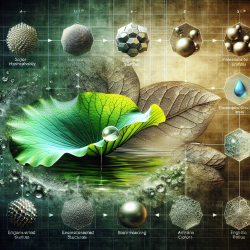As a practitioner in the field of therapy services, staying updated with the latest innovations is crucial. One intriguing area of research that holds immense potential for biomimetic applications is the study of plant surfaces. The research article "Plant Surfaces: Structures and Functions for Biomimetic Innovations" by Barthlott et al. provides a comprehensive overview of how plant surface structures can inspire innovative solutions in various fields, including therapy services.
The Fascinating World of Plant Surfaces
Plants have evolved over billions of years to develop complex surface structures that serve multiple functions. These surfaces are not only aesthetically pleasing but also possess remarkable properties such as superhydrophobicity and superhydrophilicity. The lotus leaf, for instance, is renowned for its self-cleaning ability due to its superhydrophobic surface, a phenomenon known as the "lotus effect."
Biomimetic Innovations Inspired by Nature
The intricate structures found on plant surfaces have inspired numerous biomimetic innovations. By mimicking these natural designs, researchers and engineers have developed advanced materials and technologies that offer enhanced performance and sustainability. For instance:
- Superhydrophobic Coatings: Inspired by the lotus leaf, these coatings are used to create self-cleaning surfaces in various industries.
- Water Harvesting Technologies: The ability of certain plants to capture moisture from the air has led to the development of efficient water collection systems in arid regions.
- Drag Reduction Surfaces: The unique structure of shark skin has inspired the design of surfaces that reduce friction in water, leading to more efficient marine vessels.
Applications in Therapy Services
The principles derived from plant surface structures can also be applied to improve therapy services. For example:
- Enhanced Sensory Environments: By incorporating biomimetic designs into therapy spaces, practitioners can create environments that stimulate sensory experiences and promote relaxation.
- Adaptive Equipment Design: Utilizing materials inspired by plant surfaces can lead to the development of adaptive equipment that is more comfortable and efficient for users.
- Sustainable Practices: Incorporating eco-friendly materials and designs into therapy services aligns with sustainable practices, benefiting both clients and the environment.
Encouraging Further Research
The study of plant surfaces offers a wealth of opportunities for further research and innovation. By exploring these natural designs, practitioners can uncover new ways to enhance their skills and improve service delivery. Engaging with interdisciplinary teams and staying informed through conferences, publications, and webinars will keep you at the forefront of these exciting developments.
To read the original research paper, please follow this link: Plant Surfaces: Structures and Functions for Biomimetic Innovations










